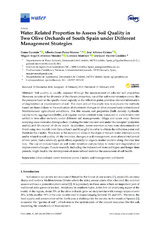Water Related Properties to Assess Soil Quality in Two Olive Orchards of South Spain under Different Management Strategies
Autor
Guzmán, Gema
Perea Moreno, Alberto Jesús
Gómez, José Alfonso
Cabrerizo-Morales, Miguel Ángel
Martínez, Gonzalo
Giráldez Cervera, Juan Vicente
Editor
MDPIFecha
2019Materia
Olive orchardWater retention curve
S index
Soil management
Soil health
METS:
Mostrar el registro METSPREMIS:
Mostrar el registro PREMISMetadatos
Mostrar el registro completo del ítemResumen
Soil quality is usually assessed through the measurement of selected soil properties.
However, in spite of the diversity of the chosen properties, use of the soil water retention curve, like
the pressure head or the specific water capacity at the inflection point, provides relevant information
of degradation or improvement of soil. The main aim of this study was to evaluate the methods
based on these indices in the evaluation of short-term changes of olive cropped soils under typical
Mediterranean agricultural conditions. For this reason, soil properties (bulk density, hydraulic
conductivity, aggregates stability, and organic matter content) were measured in a short-term trial
settled in two olive orchards under different soil managements: tillage and cover crop. Several
sampling areas were also distinguished: (i) along the inter tree row and under the canopies’ projection
and (ii) at 0–10 cm and 10–20 cm depth. In addition, water retention curves were determined and
fitted using two models (van Genutchen’s and Kosugi’s) in order to obtain the inflection point and
therefore the S index. This index is the maximum value of the slope of the soil water retention curve
and is related to soil quality. At the two sites, changes in soil management, even after a brief period
of two years, had a relatively quick effect, especially in organic matter content along the inter tree
row. The use of indices based on soil water retention curves helps to detect soil degradation or
improvement changes. Future research, including the inclusion of more soil types and longer time
periods, might lead to the development of more refined tools for the assessment of soil health

